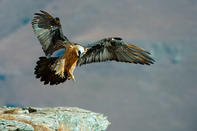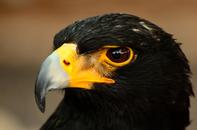Bearded Vulture

The most magnificent bird of prey is unquestionably the lammergeier, or bearded vulture, Gypaetus barbatus; it may also be the most endangered bird in Southern Africa.
Lammergeiers survive only among the highest peaks of the Drakensberg and Maluti ranges in Lesotho, relying largely on the pastoral communities to provide the bones and carrion that make up their diet.
Black Eagles

Verreaux’s eagles or black eagles, like all birds of prey, they are persecuted by many farmers, are still common occupants of the crags. They glide silently along cliff faces in search of food, hoping to surprise a dassie or small buck and knock it off the edge.
A mating pair will perform magnificent aerial acrobatics, the white crosses on their backs flashing as they turn. Sometimes they clasp talons and tumble earthwards, then disentangle and swoop up again.
Cape Vulture

Recent research has revealed that the rapid decline in numbers of the Cape vulture, Gyps coprotheres, ironically, now most numerous in the Mpumalanga, is attributable to poisoning by farmers, electrocution on power lines, but primarily to the disappearance of the wild herds that once roamed their habitat.
The consequent lack of bone calcium in its diet is responsible for many a juvenile plummeting to its death when first attempting to fly.
Bald Ibis
Bald ibises, Geronticus calvus, nest and roost on cliffs and forage for insects in open grassland. Availability of these mixed conditions being fairly limited, their range is now entirely restricted to the Drakensberg and Maluti Mountains of northern Natal and Mpumalanga.
Rock Kestrel
The rock kestrel's scientific name, Falco tinnunculus, translates as 'little bell' an apt description of its voice. The same species as Europe's common kestrel, it lives in substantial numbers in mountainous regions of Southern Africa. When hunting, the bird dives at an acute angle onto its prey.